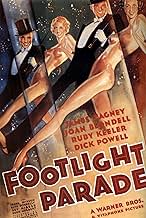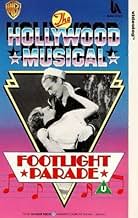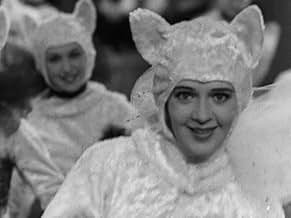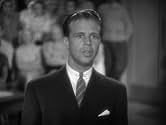Chester Kent lucha contra el tiempo, el romance y el espía de un rival para producir espectaculares "prólogos" en directo para salas de cine.Chester Kent lucha contra el tiempo, el romance y el espía de un rival para producir espectaculares "prólogos" en directo para salas de cine.Chester Kent lucha contra el tiempo, el romance y el espía de un rival para producir espectaculares "prólogos" en directo para salas de cine.
- Dirección
- Guionistas
- Elenco
- Premios
- 3 premios ganados en total
- Chorus Girl
- (sin créditos)
- Chorus Girl
- (sin créditos)
Opiniones destacadas
Sure, Warner Bros. tries to cover the orgy with the fig leaf of two cheerful innocents played by a sappy Dick Powell and a virginal Ruby Keeler. But it doesn't work, because everyone else gets in on the fun, including that human buzz-saw Jimmy Cagney and everyone's favorite sassy dame Joan Blondell. Director Lloyd Bacon proves too he knows what to do, giving us an eyeful of Blondell endlessly rolling and unrolling her hosiery, while the writers pepper the conversation with suggestive one-liners. Yeah, it's a great movie-- good enough to help bring down the heavy hand of censorship the following year, and put an end to damp dreams like "Beside a Waterfall". But not even the Watchdogs of Public Morality could stop Berkeley's deliriously suggestive pageantry that would live on at even that most repressed of studios, MGM. Sure, Astaire-Rogers may have been more graceful and a whole lot more chaste, no doubt producing more sheer polish-- still and all, don't let this unabashedly pagan celebration pass you by. As they say around the owl cage, it's a real hoot.
Busby, of course, is the undisputed master of the Hollywood musical with "Gold Diggers of 1933" and "42nd Street" to his credit (as Dance Director). Footlight Parade is graced by hundreds of scantily-clad chorus girls, a Berkeley trademark. The elaborate dance numbers were shot with only one camera and Busby was the first director to film close-ups of the dancers. His obsession with shapely legs and "rear-view" shots is amply demonstrated here. The overall effect is highly erotic and mesmerizing.
Our boy Jimmy Cagney plays Chester Kent, a producer of "prologues" or short musical stage productions that were performed in movie theaters to entertain the audience before the talkies were shown. He's surrounded by crooked partners, a corporate spy, and a gold-digging girlfriend. Although Cagney had a solid background in vaudeville, this was the first film in which he showed his dancing talents. Joan Blondell is memorable as Cagney's wise-cracking, lovestruck secretary. And Ruby Keeler is adorable, as always.
The film climaxes with three outstanding production numbers, "Honeymoon Hotel", "The Waterfall", and "Shanghai Lil", each one a masterpiece and not likely to be duplicated in today's Hollywood where so-called "special effects" have replaced creative cinematography.
Claudia's Bottom Line: Clever and erotic, with some of the best musical production numbers ever put on celluloid. A thoroughly enjoyable Depression era romp.
Cagney develops live musical prologues to be shown on stage at movie houses before the start of a film. (If you've seen the "Let's Go To The Movies" number in ANNIE you get the idea.) It's one catastrophe after another as Cagney tries to keep things running smoothly while staying a step ahead of the competition.
Joan Blondell is great as Cagney's secretary, who loves him more than he realizes. The solid cast also includes Busby Berkeley regulars Dick Powell and Ruby Keeler as a young new tenor and a secretary-turned- leading lady, respectively, with Frank McHugh as the perpetually worried dance instructor and Hugh Herbert as the morality adviser/censor. Lloyd Bacon directs the showbiz tale, with spectacular choreography by the inimitable Busby Berkeley.
I've seen this film's contemporaries (42ND STREET and GOLD DIGGERS OF 1933) and usually feel lukewarm toward these early musicals, but I found myself surprisingly receptive to FOOTLIGHT PARADE. I really liked Blondell's performance, with the romantic tension and snappy wit, and I could tolerate Keeler in her role. McHugh adds whiny comic relief and the script has some racy pre-Code touches. The film also benefits from James Cagney's screen presence. Cagney, best known for his gangster roles, demonstrates some dance steps in this rare musical appearance.
Berkeley choreographs a handful of routines (including an awkward cat- themed number), but saves the three biggest for the very end: "Honeymoon Hotel", "By A Waterfall", and "Shanghai Lil". As was often the case, the dance numbers are meant to be staged within the context of the story (a show within a show) and as was always the case, Berkeley choreographs cinematically, using camera movements, insert shots, and cuts that make no sense within the reality of the story. But his routines are meant for the moviegoers and they are awe-inspiring.
The water nymph routine will blow you away. I've seen my fair share of Busby Berkeley numbers, but the water nymph sequence may be his masterpiece. Did Berkeley invent synchronized swimming? I don't know, but he might as well have. There are unbelievable kaleidoscopic overhead shots as well as underwater choreography. I can't figure out how they did the shot of the swimmers in concentric rings, spinning in different directions, since the swimmers seemed to be lying still in the water. (Movie magic?) The more complex overhead shots are some of the most impressive visuals I've ever seen in a musical.
"Honeymoon Hotel" is a racy little number about couples spending their first night together in a hotel. Men in pajamas, women in negligees, bedrooms. There's a peculiar "child" that runs around causing mischief, but the scene has a neat larger-than-life dollhouse shot and a creative bit of stop-motion animation. "Shanghai Lil" follows a sailor through a crowded saloon in search of an elusive woman. There's a brawl, there are marching soldiers in formation, there's Ruby Keeler dolled up like a Chinese call girl, and there's Jimmy Cagney dancing and singing.
With a great cast and impressive dances, this is an enjoyable ride. Maybe the best of the early WB musicals.
Cagney is even doing a bit of singing in this one and also quite an amount of dancing. And it needs to be said that he was not bad at it. He plays the role with a lot of confidence. He apparently had some dancing jobs in his early life before his acting career started to take off big time, so it actually isn't a weird thing that he also took on some musical acting roles in his career. He obviously also feels at ease in this totally different genre than most people are accustomed to seeing him in.
The movie is directed by Lloyd Bacon, who was perhaps among the best and most successful director within the genre. His earliest '30's musicals pretty much defined the musical genre and he also was responsible for genre movies such as "42nd Street". His musicals were always light and fun to watch and more comedy like than anything else really. '30's musicals never were really about its singing, this was something that more featured in '40's and later made musicals, mainly from the MGM studios.
As usual it has a light and simple story, set in the musical world, that of course is also predictable and progresses in a formulaic way. It nevertheless is a fun and simple story that also simply makes this an entertaining movies to watch. So do the characters and actors that are portraying them. Sort of weird though that that the total plot line of the movie gets sort of abandoned toward the end of the movie, when the movie only starts to consists out of musical number routines.
The musical moments toward the ending of the movie are also amusing and well done, even though I'm not a too big fan of the genre itself. Once again the musical numbers also feature a young Billy Barty. he often played little boys/babies/mice and whatever more early on in his career, including the movie musical "Gold Diggers of 1933", of one year earlier.
A recommendable early genre movie.
8/10
http://bobafett1138.blogspot.com/
The realistic, satirical treatment gives a fresh edge to the material and its pace and line delivery are breathtaking. To think that they only started making feature talking pictures 7 years before this! The brilliance of the dialogue cannot be matched anywhere today, especially considering that "realism" has taken over and engulfed contemporary cinema.
This film was made at a time when the Hayes code restricting content was being ignored and the result is a fresh, self-referential, critical and living cinema that spoke directly to contemporary audiences suffering through the depression and the general angst of the age. I'd recommend watching any film from this period, that is 1930-1935, for a vision of what popular cinema can potentially be.
¿Sabías que…?
- TriviaFirst film where James Cagney dances - showing off his vaudeville and stage experience as a song-and-dance man. Cagney lobbied Warner Bros. to play this role. He would show off these talents to their fullest in El canto de la victoria (1942).
- ErroresAfter the "By A Waterfall" prologue ends, the film cuts to the audience giving an animated and thunderous applause, but in the balcony there is no applause or reaction. In fact, there is no movement whatsoever. They are perfectly still which indicates that a photo or painting was used for the balcony audience and then merged with the live theatre audience. The same photo/painting was also used for the "Shanghai Lil" balcony audience.
- Citas
Nan Prescott: You scram, before I wrap a chair around your neck!
Vivian Rich: [Angrily] It's three o'clock in the morning - where do you want me to go?
[Nan starts to speak, but Vivian immediately cuts her off]
Vivian Rich: You cheap stenographer...
Nan Prescott: Outside, countess. As long as they've got sidewalks YOU'VE got a job.
[Shoves her out, gives her a swift kick in the rump, and slams the door behind her]
- Versiones alternativasThere is an Italian edition of this film on DVD, distributed by DNA srl, "VIVA LE DONNE! (1933) + AMORE IN OTTO LEZIONI (1936)" (2 Films on a single DVD), re-edited with the contribution of film historian Riccardo Cusin. This version is also available for streaming on some platforms.
- ConexionesEdited into Busby Berkeley and the Gold Diggers (1969)
- Bandas sonorasA Vision of Salome
(1908) (uncredited)
Music by J. Bodewalt Lampe
Played during the prologue scene in the movie theater
Selecciones populares
- How long is Footlight Parade?Con tecnología de Alexa
Detalles
Taquilla
- Presupuesto
- USD 703,000 (estimado)
- Total a nivel mundial
- USD 276
- Tiempo de ejecución1 hora 44 minutos
- Color
- Relación de aspecto
- 1.37 : 1
Contribuir a esta página









































